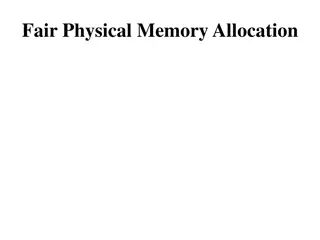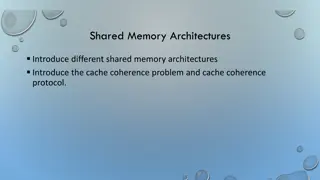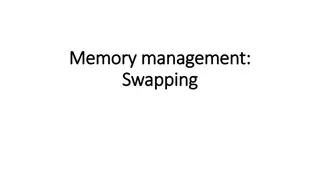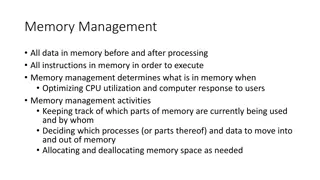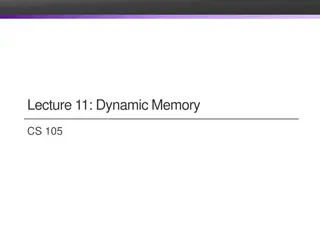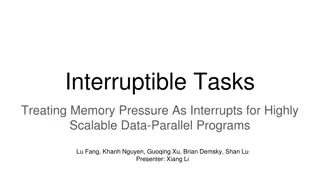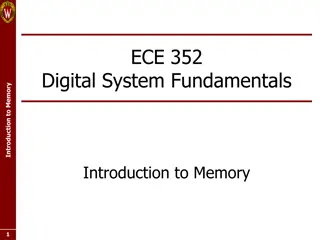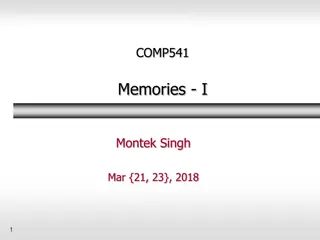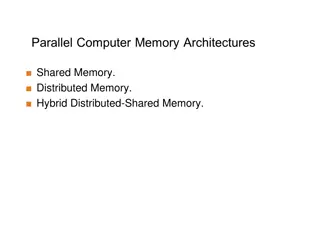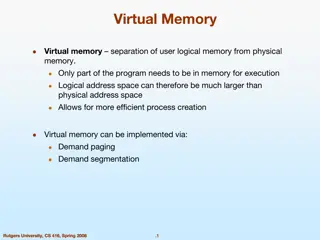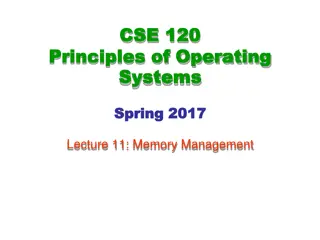Exposing Weak Memory Model Behavior
This publication delves into the challenges of parallel programming, particularly in shared-memory systems, highlighting issues like data races and semantic guarantees. It explores the complexities and limitations in ensuring correctness and scalability in such environments, offering insights into weak memory model behavior and approaches to detect and address data race issues.
Download Presentation

Please find below an Image/Link to download the presentation.
The content on the website is provided AS IS for your information and personal use only. It may not be sold, licensed, or shared on other websites without obtaining consent from the author.If you encounter any issues during the download, it is possible that the publisher has removed the file from their server.
You are allowed to download the files provided on this website for personal or commercial use, subject to the condition that they are used lawfully. All files are the property of their respective owners.
The content on the website is provided AS IS for your information and personal use only. It may not be sold, licensed, or shared on other websites without obtaining consent from the author.
E N D
Presentation Transcript
Prescient Memory: Exposing Weak Memory Model Behavior by Looking into the Future MAN CAO MAN CAO JAKE ROEMER ARITRA SENGUPTA MICHAEL D. BOND 1
Parallel Programming is Hard Shared-memory CPU Cache CPU Cache CPU Cache CPU Cache Main Memory 3
Parallel Programming is Hard Shared-memory CPU Cache CPU Cache CPU Cache CPU Cache Main Memory Difficult to be both correct and scalable 4
Parallel Programming is Hard Shared-memory CPU Cache CPU Cache CPU Cache CPU Cache Main Memory Difficult to be both correct and scalable Data race 5
Parallel Programming is Hard Shared-memory CPU Cache CPU Cache CPU Cache CPU Cache Main Memory Difficult to be both correct and scalable Data race -Fundamentally, lacks strong semantic guarantees 6
Example #1: Weak Semantics Foo data = null; boolean flag= false; T2 T1 data = new Foo(); flag = true; if (flag) data.bar(); 7
Example #1: Weak Semantics Foo data = null; boolean flag= false; T2 T1 data = new Foo(); flag = true; if (flag) data.bar(); Null pointer exception! 8
Example #1: Weak Semantics Foo data = null; boolean flag= false; No data dependence T2 T1 data = new Foo(); flag = true; if (flag) data.bar(); Null pointer exception! 9
Exposing Behaviors of Data Races Existing Approaches Dynamic analyses Model checkers 10
Exposing Behaviors of Data Races Existing Approaches Dynamic analyses - Limitation: coverage Model checkers - Limitation: scalability 11
Exposing Behaviors of Data Races Existing Approaches Dynamic analyses - Limitation: coverage Model checkers - Limitation: scalability Prescient Memory (PM) Dynamic analysis with better coverage 12
Outline Memory Models and Behaviors of Data Races Design Prescient Memory (PM) PM-profiler PM Workflow Evaluation 13
Memory Model Defines possible values that a load can return 14
Memory Model Defines possible values that a load can return Sequential Consistency (SC) Impractical to enforce Strong 15
Memory Model Defines possible values that a load can return Sequential Consistency (SC) Impractical to enforce Strong Enables compiler & hardware optimizations DRF0, C++11, Java Weak 16
Behaviors Allowed by Memory Models DRF0 Memory Model Java Memory Model (JMM) 17
Behaviors Allowed by Memory Models Strong semantics (SC) Data-race-free execution DRF0 Memory Model No semantics Racy execution Java Memory Model (JMM) 18
Behaviors Allowed by Memory Models Strong semantics (SC) Data-race-free execution DRF0 Memory Model No semantics Racy execution Java Memory Model (JMM) Strong semantics (SC) Data-race-free execution Weak semantics Racy execution 19
Behaviors Allowed by Memory Models Strong semantics (SC) Data-race-free execution DRF0 Memory Model No semantics Racy execution Java Memory Model (JMM) Strong semantics (SC) Data-race-free execution Racy execution can still lead to surprising behaviors! Weak semantics Racy execution 20
Behaviors Allowed in JMM #1: Revisit Foo data = null; boolean flag= false; T2 T1 data = new Foo(); flag = true; if (flag) data.bar(); 21
Behaviors Allowed in JMM #1: Revisit Foo data = null; boolean flag= false; T2 T1 data = new Foo(); flag = true; stale value latest value if (flag) data.bar(); 22
Behaviors Allowed in JMM #1: Revisit Foo data = null; boolean flag= false; T2 T1 data = new Foo(); flag = true; stale value latest value if (flag) data.bar(); Null pointer exception! 23
Behaviors Allowed in JMM #1: Revisit Foo data = null; boolean flag= false; T2 T1 if (flag) data.bar(); data = new Foo(); flag = true; Returning stale value can trigger the exception 24
Behaviors Allowed in JMM #2 int data = flag = 0; T1 T2 r = data; flag = 1; while (flag == 0) {} data = 1; assert r == 0; 25
Behaviors Allowed in JMM #2 int data = flag = 0; T1 T2 r = data; flag = 1; while (flag == 0) {} data = 1; assert r == 0; 26
Behaviors Allowed in JMM #2 int data = flag = 0; latest value T1 T2 r = data; flag = 1; while (flag == 0) {} data = 1; future value assert r == 0; 27
Behaviors Allowed in JMM #2 int data = flag = 0; latest value T1 T2 r = data; flag = 1; while (flag == 0) {} data = 1; future value assert r == 0; Valid due to lack of happens-before ordering 28
Behaviors Allowed in JMM #2 int data = flag = 0; latest value T1 T2 r = data; flag = 1; while (flag == 0) {} data = 1; future value assert r == 0; Assertion failure! 29
Behaviors Allowed in JMM #2 int data = flag = 0; T1 T2 while (flag == 0) {} data = 1; r = data; flag = 1; assert r == 0; Assertion failure! 30
Behaviors Allowed in JMM #2 int data = flag = 0; T1 T2 while (flag == 0) {} data = 1; r = data; flag = 1; assert r == 0; Requires returning future value or reordering to trigger the assertion failure 31
Example #3 int x = y = 0; T1 T2 r2 = y; if (r2 == 1) { r3 = y; x = r3; } else x = 1; r1 = x; y = r1; assert r2 == 0; 32
Example #3 int x = y = 0; T1 T2 r2 = y; if (r2 == 1) { r3 = y; x = r3; } else x = 1; r1 = x; y = r1; JMM disallows r2 == 1 because of causality requirements assert r2 == 0; ev k and Aspinall, ECOOP, 2008 33
Example #3 However, in a JVM, after redundant read elimination int x = y = 0; T1 T2 r2 = y; if (r2 == 1) { r3 = r2; x = r3; } else x = 1; r1 = x; y = r1; assert r2 == 0; 34
Example #3 However, in a JVM, after redundant read elimination int x = y = 0; T1 T2 r2 = y; if (r2 == 1) { r3 = r2; x = r3; } else x = 1; r1 = x; y = r1; r2 = y; If (r2 == 1) x = r2; else x = 1; assert r2 == 0; 35
Example #3 However, in a JVM, after redundant read elimination int x = y = 0; T1 T2 r2 = y; if (r2 == 1) { r3 = r2; x = r3; } else x = 1; r1 = x; y = r1; r2 = y; If (r2 == 1) x = r2; else x = 1; r2 = y; x = 1; assert r2 == 0; 36
Example #3 However, in a JVM, after redundant read elimination int x = y = 0; T1 T2 r2 = y; if (r2 == 1) { r3 = r2; x = r3; } else x = 1; r1 = x; y = r1; r2 = y; If (r2 == 1) x = r2; else x = 1; r2 = y; x = 1; Assertion failure possible! assert r2 == 0; 37
Behaviors Allowed by Memory Models and JVMs DRF0 Memory Model Java Memory Model Typical JVMs 38
Behaviors Allowed by Memory Models and JVMs DRF0 Memory Model Unsatisfactory, impractical to enforce Java Memory Model Typical JVMs 39
Exposing Behaviors of Example #3 Consider future value int x = y = 0; T1 T2 r1 = x; y = r1; r2 = y; if (r2 == 1) { r3 = y; x = r3; } else x = 1; assert r2 == 0; 40
Exposing Behaviors of Example #3 Consider future value int x = y = 0; T1 T2 r1 = x; // r1 = 1 y = r1; // y = 1 r2 = y; // r2 = 1 if (r2 == 1) { r3 = y; // r3 = 1 x = r3; // x = 1 } else x = 1; assert r2 == 0; 41
Exposing Behaviors of Example #3 Consider future value int x = y = 0; T1 T2 r1 = x; // r1 = 1 y = r1; // y = 1 r2 = y; // r2 = 1 if (r2 == 1) { r3 = y; // r3 = 1 x = r3; // x = 1 } else x = 1; r1 = 1 justified! Assertion failure! assert r2 == 0; 42
Exposing Behaviors of Example #3 int x = y = 0; T1 T2 r2 = y; if (r2 == 1) { r3 = y; x = r3; } else x = 1; r1 = x; y = r1; assert r2 == 0; Requires returning future value or compiler optimization and reordering to trigger the assertion failure 43
Exposing Behaviors with Dynamic Analyses Typical approaches Simulate weak memory models behaviors [1,2,3] Explore multiple thread interleavings [4, 5] 1. 2. 3. 4. 5. Adversarial Memory, Flanagan & Freund, PLDI 09 Relaxer, Burnim et al, ISSTA 11 Portend+, Kasikci et al, TOPLAS 15 Replay Analysis, Narayanasamy et al, PLDI 07 RaceFuzzer, Sen, PLDI 08 44
Exposing Behaviors with Dynamic Analyses Typical approaches Simulate weak memory models behaviors [1,2,3] Explore multiple thread interleavings [4, 5] Coverage Limitation Return stale values only, not future values Cannot expose assertion failures in Examples #2, #3 1. 2. 3. 4. 5. Adversarial Memory, Flanagan & Freund, PLDI 09 Relaxer, Burnim et al, ISSTA 11 Portend+, Kasikci et al, TOPLAS 15 Replay Analysis, Narayanasamy et al, PLDI 07 RaceFuzzer, Sen, PLDI 08 45
Relationship among memory models and exposed behaviors DRF0 Memory Model Java Memory Model Existing Dynamic Analyses Typical JVMs 46
Relationship among memory models and exposed behaviors DRF0 Memory Model Our Goal Java Memory Model Existing Dynamic Analyses Typical JVMs 47
Relationship among memory models and exposed behaviors DRF0 Memory Model Example #3 r1 = x; r2 = y; y = r1; if (r2 == 1) { Our Goal r3 = y; x = r3; } else x = 1; Java Memory Model Existing Dynamic Analyses Example #2 r = data; while (flag == 0) {} flag = 1; data = 1; Typical JVMs Example #1 data = new Foo(); if (flag) flag = true; data.bar(); 48
Relationship among memory models and exposed behaviors Real-world evidence is valuable here! DRF0 Memory Model Example #3 r1 = x; r2 = y; y = r1; if (r2 == 1) { Our Goal r3 = y; x = r3; } else x = 1; Java Memory Model Existing Dynamic Analyses Example #2 r = data; while (flag == 0) {} flag = 1; data = 1; Typical JVMs Example #1 data = new Foo(); if (flag) flag = true; data.bar(); 49
Outline Memory Models and Behaviors of Data Races Design Prescient Memory (PM) PM-profiler PM Workflow Evaluation 50


